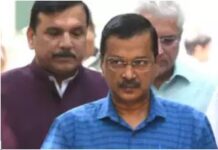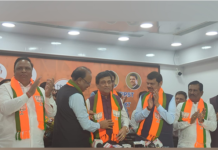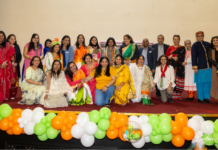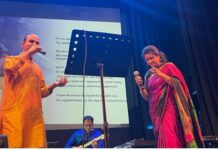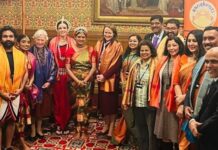Hindus largely perceived as weak, not great soldiers, and yet they had been involved in fighting wars for other than themselves. Among the first foreign forces were Hindus to fight for British on Western front.[2]
While the plans for centenary commemorations of the First World War undergo this week, today’s generation know virtually nothing about the sacrifices of those who laid their lives in the war.
At the onset of the war itself it was abundantly clear to allies that additional troops from India were necessary to fight in North Africa, Europe and the Middle East.[3]

Indian soldiers in First World War. Source: http://www.oldindianphotos.in/2010/12/indian-troops-in-first-world-war.htm
It was the war India had supported British by all means – Political, military and economic. At a time when majority of Indians were suffering from abject poverty, they gifted 100 million pounds for war. The support was in expectation of British’s sensitive hearing towards plea for Indian independence, which post war British were in no hurry to fulfil.[4]

Indian soldiers in First World War. Source: http://www.oldindianphotos.in/2010/12/indian-troops-in-first-world-war.htm
Indian army comprised men of diverse faiths. The role of Hindus in the First World War is by and large expunged from the history books. Merely a cursory gaze at the figures reveals startling fact – In total 1,338, 620 Hindus participated in the war. This number exceeds the total number of army personnel from Australia, Canada, New Zealand and South Africa by 178,000[5].
Hindu soldiers were involved in the lands as diverse as Palestine, France, Syria and Mesopotamia. A school of thought says it was the Hindu army which changed the course of the war by turning German soldiers at Marne.
Thousands of Hindu soldiers lost their lives and no hero’s welcome awaited the survivors, such was their fate.

Source: http://www.bl.uk/world-war-one/articles/the-indian-sepoy-in-the-first-world-war
The war graves in France and Belgium are grim reminder of largely anonymous Hindu soldiers. One of them was Mir Dast, Victoria Cross holder, British highest award of gallantry. He was the officer of 57th Rifles of the Indian Army, who came under vicious gas attack by Germans in April 1915. As he held his defence against the army, without a gas mask, he managed to save lives of eight officers.[6]
Lying in the hospital bed at Brighton, England, he wrote to his family that he was twice wounded, once in the hand and second from gas.

Source: http://www.bl.uk/world-war-one/articles/the-indian-sepoy-in-the-first-world-war
Traces of Hindu participation are fragmented by the fact that only a limited record of correspondence exist between Hindu soldiers and their families. The reason being most Hindu soldiers were illiterate. They would have one of the literate ones among them write the letter. The letter would then be read out to British officer as part of censorship procedure to restrict passing of militarily sensitive information to the enemy before being dispatched off to the recipient’s village.
These letters and diaries are the source of information on the anguish felt by the soldiers about the war. The soldiers talk about guns, poisonous gas, destruction, yearning of family. Hindu soldiers would often refer to great Hindu war epic Mahabharata and compare the war of good versus evil to the current one. One of the soldiers wrote that having witnessed the current war, end of the world seems near and all that was written in Mahabharata and Ramayana appears to be true to him.[7]
Extracts of these letters could be sourced from summaries prepared at the time of censoring of letters. The digital versions of the summaries are available at Europeana and British Library.
The war could also be remembered for the caste discrimination faced by Hindu soldiers. British insisted on maintaining the fault lines of caste system. Recruitment in the army was carried on the assumption that some races were martial races. Majority of army men were sourced from North and Northwest India.[8]

Indian soldier in the Royal Pavilion, Brighton, England. 1914-18 Source: http://www.black-history.org.uk/pavilionindian.asp
The caste system was practiced by British even in the hospitals where Hindu soldiers were treated. Royal Pavilion Hospital in Brighton, where the wounded soldiers were treated, ensured the hospital wards were segregated on caste lines. The so called ‘untouchables’ were employed as support staffs.[9]
According to Richard Smith, lecturer at Goldsmith College, University of London, and author of Jamaican Volunteers in the First World War, discrimination faced by the volunteers in the army worked as catalyst for them to join the movements for independence in their respective countries.[10]
Chatri (which means Umbrella in English), is the only memorial of significance to honour the contribution of Hindu and Sikh soldiers. The monument is on the Downs, near Patcham in Brighton. It was unveiled by the Prince of Wales on 21st February 1921. [11] It is a cremation site for fifty three Hindus and Sikhs soldiers.
In 2010, their names were inscribed in stones on the site. It is truly disappointing is that it has taken over a century after their deaths that Commonwealth War Graves Commission to inscribe the names of the martyrs. [12]
Courtesy:

Readers like you, make ESHADOOT work possible. We need your support to deliver quality and positive news about India and Indian diaspora - and to keep it open for everyone. Your support is essential to continue our efforts. Every contribution, however big or small, is so valuable for our future.

